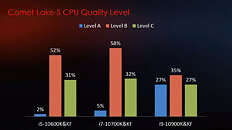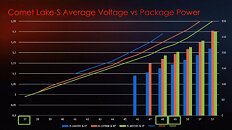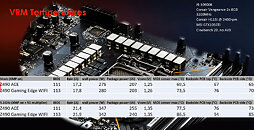Wednesday, May 6th 2020

MSI Shares Fascinating Insights Into "Comet Lake" Binning
MSI in its weekly "MSI Insider" livestream shared fascinating insights into the way Intel appears to be sorting out its "Comet Lake" silicon across the various brand extensions of its 10th generation Core desktop processors. Its tech leads Eric Van Beurden and Michiel Berkhout spoke at length about MSI's own evaluation of the trays of Core i5-10600K/KF, i7-10700K/KF, and i9-10900K/KF chips it received (the only unlocked chips across the lineup), which they used as empirical evidence to suggest a model for Intel's binning.
MSI segregated the chips it received into three categories. Level A consists of chips that overclock higher than Intel's specifications (overclocking headroom higher than expected). Level B consists of those that overclock within Intel's specifications. Level C, on the other hand, have their overclocking headroom fall below Intel's specifications. It's important to note here that "Intel specification" doesn't mean "stock frequencies," it refers to the overclocking headroom Intel communicates to motherboard manufacturers, to give them an idea of the minimum board design requirements needed to guarantee overclocking within these specifications, for their Z490 motherboards. These are more of a guideline in nature, all three levels will overclock above stock frequencies.In its testing, MSI found that only 2% of the i5-10600K/KF chips went above and beyond Intel specifications, qualifying for Level A. For the i7-10700K/KF, this number stands at only 5%. It's only with the i9-10900K/KF that the number shoots up to 27%. So your chances of getting a golden i5-10600K/KF or i7-10700K/KF are rather slim.
Moving on, a majority of both the i5-10600K/KF and i7-10700K/KF overclock within Intel specifications, with 52% of the i5-10600K/KF qualifying for Level B, and 58% of the i7-10700K/KF. 35% of the i9-10900K/KF qualify for this bin. Lastly, nearly 1/3rd of all three chips fall below Intel specifications, ending up in Level C. That's 31% of the i5-10600K/KF, 32% of the i7-10700K/KF, and 27% of the i9-10900K/KF.
The distribution of the three bins is a lot more uniform with the i9-10900K/KF than it is with the i7-10700K/KF and the i5-10600K/KF, and so MSI suggests that you have a much better chance of landing a good Level B or great Level A chip with the i9-10900K/KF. Level C taking up nearly 1/3rd of all three chips is a cause for concern indeed.
The second graph (above) talks about the voltage vs. average package power relationship among the three bins, to show you just how stark the differences between Level A and Level C are.
Find more comments by MSI in the video below.
Source:
VideoCardz
MSI segregated the chips it received into three categories. Level A consists of chips that overclock higher than Intel's specifications (overclocking headroom higher than expected). Level B consists of those that overclock within Intel's specifications. Level C, on the other hand, have their overclocking headroom fall below Intel's specifications. It's important to note here that "Intel specification" doesn't mean "stock frequencies," it refers to the overclocking headroom Intel communicates to motherboard manufacturers, to give them an idea of the minimum board design requirements needed to guarantee overclocking within these specifications, for their Z490 motherboards. These are more of a guideline in nature, all three levels will overclock above stock frequencies.In its testing, MSI found that only 2% of the i5-10600K/KF chips went above and beyond Intel specifications, qualifying for Level A. For the i7-10700K/KF, this number stands at only 5%. It's only with the i9-10900K/KF that the number shoots up to 27%. So your chances of getting a golden i5-10600K/KF or i7-10700K/KF are rather slim.
Moving on, a majority of both the i5-10600K/KF and i7-10700K/KF overclock within Intel specifications, with 52% of the i5-10600K/KF qualifying for Level B, and 58% of the i7-10700K/KF. 35% of the i9-10900K/KF qualify for this bin. Lastly, nearly 1/3rd of all three chips fall below Intel specifications, ending up in Level C. That's 31% of the i5-10600K/KF, 32% of the i7-10700K/KF, and 27% of the i9-10900K/KF.
The distribution of the three bins is a lot more uniform with the i9-10900K/KF than it is with the i7-10700K/KF and the i5-10600K/KF, and so MSI suggests that you have a much better chance of landing a good Level B or great Level A chip with the i9-10900K/KF. Level C taking up nearly 1/3rd of all three chips is a cause for concern indeed.
The second graph (above) talks about the voltage vs. average package power relationship among the three bins, to show you just how stark the differences between Level A and Level C are.
Find more comments by MSI in the video below.



30 Comments on MSI Shares Fascinating Insights Into "Comet Lake" Binning
It's obviously not completely wrong, but should be taken with a pinch of salt when it comes to the binning and the performance you can expect to get from your CPU if you buy one of these.
A real distribution is always a bell curve; in this case the left hand side has been truncated.
Note the third graph; it's a normal distribution.
I'm sure those processors exist somewhere. :)
They just didn't pay the jack to get a normal distribution, if I had to guess. :D
Yes, maybe Intel did give them some "B" grade CPUs for the lower SKUs, but I don't think it's all that likely, as Intel normally doesn't do selective testing on the parts they give to the board makers, they just give them a tray or two of each kind to test with.
Note again that these are QS (Qualification Samples), i.e. intended for the boards makers to do final checks with and near MP grade silicon.
I hope you don't expect that the i5 chips should clock as high as the i9 chips?
Also, it seems like MSI messed up the Voltage vs Package power graph, as all chips are i5's in it...
I've done manufacturing for years, and the right two distributions are not normal; the third one is.
This one.
The only way you get this distribution in a herd of cows is if you shoot most of the blue cows, lol.
As an overclocker, I'm personally looking for those Blue Cows. :)
My question is what distributor is selling the unicorns?
:)
I don't think you understand how chip binning works. For starters, the i9 is the "goal" when a wafer of chips is produced. Ideally, a the whole wafer should be i9 parts only. However, that's never going to happen, as there are always some defects. Then the parts at the centre of that wafer are going to clock higher than the ones further out and the ones at the edge clocks the worse, as that's silicon manufacturing for you. As such, only something like 30% are going to meet the screening requirements to end up as an i9. Within that 30%, you're then going to have a variance, which is what you're seeing here.
Normal manufacturing logic doesn't apply to complex ICs of this kind and that's why there's the silicon lottery when you're buying a CPU. Some of us luck out, some us get a dud. I have worked with and know a lot of the "professional" overclockers and I have covered more overclocking events than I care to remember. The board makers goes through about 20 trays of CPUs before a competition and out of those 20 trays, about four or five are brought along to the competitions, after having been sorted and tested by the in-house overclocker at whoever has the competition. Then the overclockers get to draw straws of who gets to pick first, but they have no idea how far those chips will overclock. There's always a variance that's pretty close to what we're seeing here, despite the fact that only the top chips even make it that far, the rest that gets left in the office, are obviously the "C" grade stuff.
For retail, if you get say an i9, you're obviously always going to get a CPU from the top 30% of what Intel makes for the consumer market. However, Intel never guarantees clock speeds, hence the "up to" in all their materials. This is also why people seemingly are willing to pay much more than MSRP to get pre-binned chips these days. Some overclockers even buy a tray or two of CPUs and do their own binning, just so they have a good chip to bench at home.
This is your go to place, if you want a pre-screened chip. No prices yet though.
siliconlottery.com/collections/cometlake
But each CPU has special traces and test points that define it's quality, and then they probably get a second test to see what model the die will be. That distribution curve isn't bad, it's Intel utilizing the best cores for the premium models.
They test them at increasing levels of abuse, even before they are encapsulated.
They know exactly which ones are which, from the moment they are born. (as a die...)
There are several streams that the overall product goes into; the one referenced above is light on overclockers; my eye standard deviation detector is as good as my calculations: it's not a likely distribution.
I am not saying MSI got ripped off or anything; they just didn't pay for more.
Currently both of you can be correct.
Why?
Because we don't know how the binning is done in Comet lake - S yet.
Using I9 10900K as an example, its an 10 core chip. As die size get larger, chance of defect become greater. However, if past history remain true, usually Intel doesn't use chip with disabled core for their top end product. Thus, 10900K should be a 10 core die (at least what I guessed), with no disabled core.
As for the I5 and I7 K part, there are two different scenario.
If Intel want best performance out of these I5 K/ I7 K part, usually they should use chip with all core activated for K chip.
If indeed Intel only use chip with all core activate, binning should follow bell curve, assuming that the ''Intel specification'' is the close to the true average K series suppose performance. (Huge assumption here)
However, we simply don't know, if Intel used chip with disabled core from larger die, these chip will likely overclock worse.
It is possible that Intel reserved certain better performing K chip for OEMs, but we don't have enough information to determine what's true, not until we have more information on die composition and manual overclocking performance yet.
TLDR: Too much information unknown, arguing now isn't particularly useful.
You seemingly have your own ideas about things, but it's not correct in this case.
Just out of curiosity, how many Intel fabs, or any kind of semiconductor fab have you been to? I've been to several over the years and have sat through multiple chip manufacturing seminars and press briefings, but by all means, please ignore me.Again QS parts, not retail.Most likely yes, but the "C" parts for a certain type of CPU should in theory not fall behind a certain given criteria. However, Intel has clearly covered their assess, by stating up to.
Maybe I'm reading this wrong.. @TheLostSwede?
By far, the biggest issue is trying to cool these, especially when heavily overclocked, not paying for the power difference.
I pay $0.09531 per kilowatt hour.
What do you pay in Brazil?
Thats bad cause the Brazilian minimum wage is BRL 1040. quick conversin 4 = 1. Brazilian minimum wage is USD 260, per month. yeah brazil sucks.